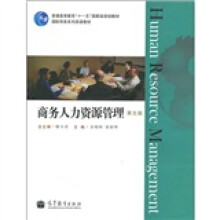Part I For Students
Chapter I Introduction to Human Resource Management
1.1 What Is Human Resource Management?
1.2 HRM Functions
1.3 The Changing Environment of HRM
1.4 The Changing Role of HRM
1.5 Strategic Human Resource Management
1.6 Competencies of the Human Resource Manager
Chapter 2 Career Planning
2.1 Self Development
2.2 Roles in Career Development
2.3 Factors That Affect Career Choices
2.4 Becoming an Entrepreneur: Four Steps to Entrepreneurship
Chapter 3 Job Analysis
3.1 What Is Job Analysis?
3.2 Writing Job Descriptions
3.3 Writing Job Specifications
3.4 Job Design
Chapter 4 Human Resource Planning
4.1 Strategic Human Resource Planning
4.2 Stages of Human Resource Planning
4.3 Reasons for Human Resource Planning
4.4 How to Forecast Personnel Needs
4.5 Forecasting the Supply of Inside Candidates
4.6 Succession Planning
Chapter 5 Recruiting Employees
5.1 Recruiting
5.2 Labor Ma,'kets
5.3 Strategic Recruiting Stages
5.4 Recruiting Source Choices: Internal vs. External
5.5 Recruiting Over the Internet
Chapter 6 Selecting Employees
6.1 The Importance of Selection
6.2 The Nature of Selection
6.3 Environmental Factors Influencing Selection
6.4 Basic Requirements of Selection
6.5 Selection Process
6.6 Employment Tests
6.7 Reference Checks and Recommendations
6.8 Physical Examinations
Chapter 7 Training Employees
7.1 Employee Orientation
7.2 The Training Process
7.3 Training Needs Analysis
7.4 Training Techniques
7.5 Creative Training Over the Internet
Chapter 8 Permance Appraisal
8.1 The Performance Appraisal Process
8.2 Why Appraise Performance?
8.3 Methods for Appraising Performance
8.4, Performance Appraisal: Problems and Solutions
8.5 How to Avoid Appraisal Problems
Chapter 9 Organizational Renewal
9.1 Organizational Change and Development
9.2 HRM and Total Quality Management
9.3 How HR Helps to Create Team-based Organizations
9. 4 How HR Helps to Build Productive Teams
9.5 What Is Business Process Reengineering?
9.6 Flexible Work Arrangements
……
Part Ⅱ For Teachers

 缺书网
缺书网 扫码进群
扫码进群
 缺书网
缺书网 扫码进群
扫码进群